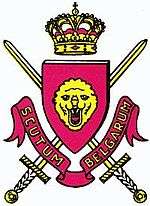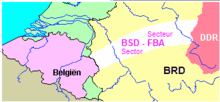Belgian Forces in Germany
The Belgian Forces in Germany (French: Forces belges en Allemagne or FBA, Dutch: Belgische strijdkrachten in Duitsland, BSD) was the name of Belgium's army of occupation in West Germany after World War II. Lasting between 1946 and 2002, the army corps-strength FBA-BSD formed part of the NATO force guarding Western Europe against Warsaw Pact during the Cold War. At its height, 40,000 soldiers were serving with the unit with several thousand civilians also living in the Belgian zone around Cologne.
| Belgian Forces in Germany (FBA-BSD) | |
|---|---|
 Insignia with the badge of First Corps[1] in the centre. | |
| Active | 1946–2002 |
| Country | |
| Allegiance | |
| Branch | Belgian army |
| Role | Army of occupation (1945-1955) Defense of West Germany (1955-2002) |
| Size | 40,000 men (at height) |
| Part of | |
| Motto(s) | Scutum Belgarum ("Shield of the Belgians") |
| Commanders | |
| Notable commanders | Jean-Baptiste Piron (1946–51) Albert Crahay (1960–64) |
History

In the aftermath of World War II, Belgian troops were deployed to Germany as part of the Allied occupation force. From 1 April 1946, three Belgian infantry brigades of I Corps were present.[2] Shortly after, the Belgians were given their own zone with operational autonomy in the sector controlled by the British. The territory in question covered the cities of Aachen, Cologne, Soest, Siegen and Kassel in North Rhine-Westphalia. There was also a Belgian garrison in Bonn until 1949 when West Germany was created.
By the 1950s, West Germany was on the frontline of the Cold War. Once West Germany joined NATO in May 1955, the mission of the FBA-BSD changed from being an "army of occupation" to being an "army of protection", guarding a 60 kilometres (37 mi)-wide strip of German territory from the border with East Germany to the German-Belgian border against Warsaw Pact attack. It was assigned to NATO's Northern Army Group (NORTHAG). At its height, 40,000 Belgian soldiers were stationed in Germany and a total of 70,000 Belgian nationals lived in the zone.[3] At the end of the Cold War in November 1989, there were 24,000 soldiers in the FBA-BSD.[4] A large number of those who served were conscripts deployed to the force as part of their national service.[2]

Because of the presence of large numbers of Belgian citizens, both soldiers and their families, the region was seen by some as a "tenth province" (dixième province) of Belgium.[4] Over the course of the Belgian occupation, hundreds of thousands of Belgian citizens lived in the area with their families. Plans for the evacuation of families in event of war were also drawn up. A newspaper, entitled Vici, was published for the unit.
At the end of the Cold War, the Belgian government launched a plan to restructure the entire Belgian army between 2000 and 2015.[4] Belgian forces in Germany began a period of staged withdrawal known as "Reforbel".[4] The final Belgian barracks (Troisdorf-Spich) was shut on 31 August 2004. Some soldiers remained in Vogelsang Camp, across the frontier, until 2005. 450 "mixed" Belgian-German families opted to remain in Germany after the military withdrawal.[3]
Today a museum in Soest, Germany is dedicated to the history of the FBA-BSD.[5] The Royal Museum of the Armed Forces in Brussels held a temporary exhibition on the subject, entitled "Belgian soldiers in Germany, 1945–2002", in 2011.[6]
See also
- Belgium in World War II
- Belgian United Nations Command (1950–55)
- European Defence Community (1950–52)
References
- "Les FBA". users.skynet.be/les.cuirassiers. Retrieved 10 January 2013.
- "Forces belges en Allemagne". La Libre Belgique. Belga. 13 February 2002. Retrieved 5 March 2016.
- "Les militaires belges en Allemagne, c'est fini!". La Libre Belgique. Belga. 6 June 2002. Retrieved 5 March 2016.
- "La page des FBA est définitivement tournée". La Libre Belgique. Belga. 30 December 2005. Retrieved 5 March 2016.
- "Musée des Forces Belges en Allemagne". www.museum-bsd.de. Archived from the original on 20 April 2012. Retrieved 10 January 2013.
- "Des soldats belges en Allemagne 1945 – 2002". www.klm-mra.be. Archived from the original on 15 January 2013. Retrieved 10 January 2013.
Further reading
- Brüll, Christoph (2011). "Entre ressentiment et ré-éducation. L'Armée belge d'Occupation et les Allemands, 1945-1952" (PDF). Cahiers d'Histoire du Temps Présent. 23: 55–94.
- Brüll, Christoph (2009). Belgien im Nachkriegsdeutschland : Besatzung, Annäherung, Ausgleich (1944-1958). Essen: Klartext. ISBN 9783837502527.
External links
| Wikimedia Commons has media related to Belgium during the Cold War. |
- "Le site des ex-Forces Belges en Allemagne". Retrieved 10 January 2013.
- "Musée des Forces Belges en Allemagne". www.museum-bsd.de. Archived from the original on 20 April 2012. Retrieved 10 January 2013.